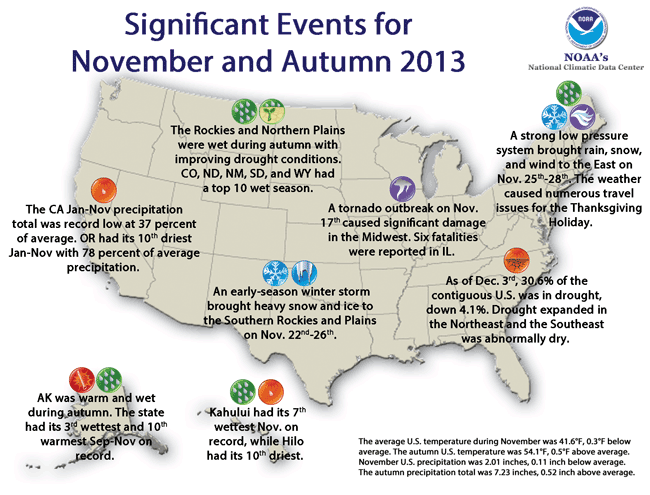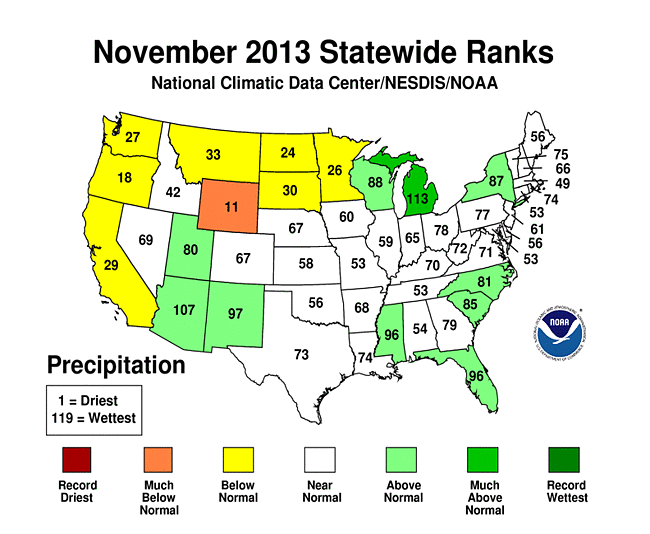Monthly Report Summary Information
The Monthly Report Summary Information is a synopsis of the collection of national and global summaries released each month.
National Summary Information - November 2013
See Full Report
Contiguous U.S. experiences wetter and warmer than average autumn, while November was drier and cooler than average.
Lower-48 drought footprint shrank to 30.6 percent by early December; Alaska experienced its 10th warmest autumn.
The average temperature for the contiguous U.S. during the autumn season (September-November) was 54.1°F, slightly above the 20th century average. The November temperature was 41.6°F and slightly below the 20th century average.
The total autumn precipitation averaged across the contiguous U.S. was 7.23 inches, 0.52 inch above average, marking the 34th wettest autumn on record. The November national precipitation total was 0.11 inch below average at 2.01 inches.

Significant climate events for November 2013. Click image to enlarge, or click here for the National Overview.
Note: The November Monthly Climate Report for the United States has several pages of supplemental information and data regarding some of the exceptional events from the month and season.
U.S. climate highlights: autumn (September-November)
- A large portion of the contiguous U.S. had Above-average temperatures were observed in parts of the Rockies and in Florida.
- Alaska experienced its 10th warmest autumn in its 95-year period of record with a statewide average temperature 4.0°F above the 1971-2000 average. The autumn warmth was driven in large part by the record warm October in the state. This was the warmest autumn in Alaska since 2002.
- Above-average precipitation was also observed for the western Gulf Coast states and parts of the Midwest and Intermountain Basin.
- Alaska experienced its third wettest autumn on record with a statewide precipitation total 42.7 percent above the 1971-2000 average. This marked the wettest autumn for the state since 1993 when the seasonal precipitation total was 52.0 percent above average.
- The U.S. Climate Extremes Index (USCEI) during autumn was much below average and the 16th lowest value on record for the season. Elements that were above average include the spatial extent of wetness and days with precipitation. The USCEI is an index that tracks the highest and lowest 10 percent of extremes in temperature, precipitation, tropical cyclones, and drought across the contiguous United States.
- Above-average temperatures were present for the Southwest, as well as Florida. No state had November temperatures ranking among the ten warmest or coolest.
- Wyoming had its 11th driest November on record with a monthly precipitation total 46 percent of average.
- Michigan had its seventh wettest November on record with a precipitation total of 4.12 inches, 1.68 inches above the 20th century average.
- According to analysis by the Rutgers Global Snow Lab, the November snow cover extent across the contiguous U.S. was the 12th largest in the 48-year period of record at 591,000 square miles, 116,000 square miles above the 1981-2010 average. Conversely, the Alaska snow cover extent was 11,000 square miles below average, and its 12th smallest November snow cover extent on record.
- According to the December 3rd U.S. Drought Monitor report, 30.6 percent of the contiguous U.S. was in drought, down from 34.7 percent at the end of October. Drought improved for the Lower Mississippi River Valley and parts of the Midwest. Drought conditions expanded in the Northeast, and abnormally dry conditions expanded in the Southeast. Extreme drought conditions expanded to cover 27.6 percent of California.
- The year-to-date contiguous U.S. temperature was 54.4°F, 0.5°F above the 20th century average, the 35th warmest January-November on record. Above-average temperatures were observed in the West, Northeast, and Florida.
- The year-to-date contiguous U.S. precipitation total of 29.00 inches was 2.09 inches above the 20th century average and the 19th wettest January-November on record.
- Much of the contiguous U.S. was Michigan both had their wettest January-November on record. The North Dakota precipitation total of 23.62 inches was 6.72 inches above average, and the Michigan precipitation total of 37.78 inches was 8.63 inches above average.
- Oregon had its 10th driest January-November while California was record dry. The California year-to-date precipitation total of 7.01 inches was 11.88 inches below average and 1.63 inches below the previous record dry January-November of 1898.
- The components of the USCEI that examine extremes in 1-day precipitation totals and the spatial extent of drought ranked as the ninth and 15th highest on record for January-November, respectively. When combining all components of the USCEI, the index was slightly below average.
 NOAA's National Centers for Environmental Information
NOAA's National Centers for Environmental Information



